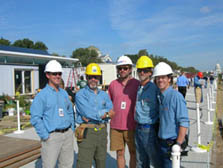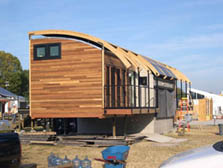

The instrumentation team from NREL is busy installing monitoring equipment in anticipation of the measured contest activities. From left to right: Charles Newcomb, Norm Weaver, Greg Barker, Ed Hancock, and Paul Norton.

With just some clean up work left to do, the University of Maryland's house is finished!
Solar Decathlon 2005
Daily Journal — October 3, 2005
As you probably know, the objective of the Solar Decathlon is to design and build an attractive house that provides its own power and is totally self-sufficient. The houses are judged for design aesthetics and appeal, but they must also be fully functional. The competition requires that the students "live" in their houses for a week, taxing them hard. They can't actually sleep in their houses, but the houses must perform all the functions of a typical home—using only solar energy. In the end the competition determines which ones look, and work, the best.
To determine which house works the best, technicians from the National Renewable Energy Laboratory (NREL) will install monitoring instruments. Each house will have sensors placed in strategic spots to measure energy usage. Photometers will measure light levels in all the rooms. Temperature sensors will measure indoor room temperature, freezer and refrigerator temperature, and hot water temperatures. Voltmeters will measure production of electricity from solar panels. Indoor humidity levels will also be measured. There are 10-15 sensors throughout each house that will be used to score all or portions of six contests. From a scientific point of view, the Solar Decathlon village with its 18 houses is the largest, most comprehensive side-by-side experiment of its kind. We are not only running an exciting competition, we are making history.
This weekend I had time to watch some of the University of Maryland and University of Virginia football game. I couldn't help but marvel at the athletes' abilities to run around defenders fast while throwing or catching a pass with amazing accuracy. Athletics celebrate all those who depend on their physical ability to survive. The Solar Decathlon celebrates those who depend on their mental abilities.
The decathlon challenges students to be creative, resourceful, and inquisitive—to thirst for knowledge that leads to developing something new and better. This competition challenges our best and brightest to not only outsmart their peers, but to take the result of that powerful effort and turn it into something beneficial to everyone. Those who are attracted to this kind of challenge understand that it not only enhances their learning experience in college but that it also benefits others—their schools, their children, and all creation.
Now for an update on team progress. As of 5:30 p.m. all but two teams now have fully enclosed houses: the University of Michigan and the Rhode Island School of Design. Michigan had their end pieces delivered yesterday, but couldn't get use of a crane to lift them into place. They are out there as I write, using a forklift to move them. Hopefully by morning when I come back the Michigan house will be fully enclosed. Rhode Island used a crane today to lift their final section into place. Now all they have to do is install their curtain wall, and their house will be enclosed.
The University of Maryland's house is finished! This afternoon they were going around asking if some other teams could use some help, because they didn't have anything to do. Go Terps!
But there's still a lot to do in the little time remaining before opening ceremonies on Thursday....
Reporting from the village
Richard King, Department of Energy
